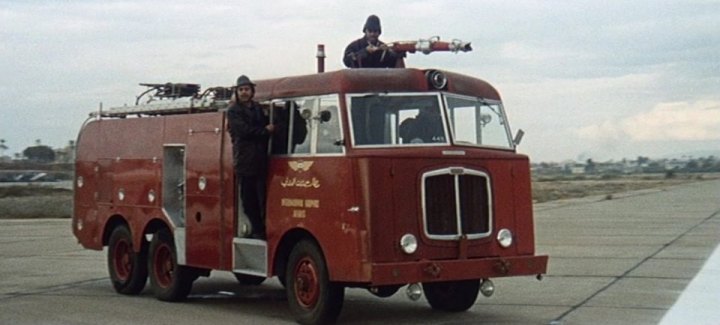 Advertising
Advertising  Last completed movie pages
Last completed movie pages  Douglas unknown Airport fire tender
Douglas unknown Airport fire tender
Class: Trucks, Fire truck — Model origin:  — Made for:
— Made for: 

![]() 00:02:56
00:02:56 ![]()
![]() Minor action vehicle or used in only a short scene
Minor action vehicle or used in only a short scene
 Comments about this vehicle
Comments about this vehicle| Author | Message |
|---|---|
|
◊ 2019-03-13 21:36 |
A British fire engine. |
|
◊ 2019-03-13 21:55 |
AEC Mercury ? or Thornycroft Nubian ? -- Last edit: 2019-03-13 22:01:32 |
|
◊ 2019-03-13 22:15 |
That is not an AEC grille. Thornycroft usually but not always feature a large “T” on the grille, so this could be. The other question is who built the bodywork. Having been involved in the construction of fire fighting vehicles I am aware that strange things happen. |
|
◊ 2019-03-16 20:24 |
Gut feeling is Douglas who made many virtual one offs ,axles and wheels too light for a Nubian , bodywork looks very British. |
|
◊ 2019-03-16 20:54 |
Only photo of Douglas fire engine / crash tender I can find is this Commer based 4x4. The skinny and unusual wheels front and back match and note central front diff. Link to "archive.commercialmotor.com" -- Last edit: 2019-03-17 08:57:37 |
|
◊ 2019-03-17 08:33 |
From Flight magazine, a description of the 6x6, shame they headlined it with photo of the 4x4 -![[Image: 2019-03-173.jpg]](http://pics.imcdb.org/th3808/2019-03-173.jpg) This is one of a wide range of Douglas petrol- and dieselengined fire tenders, of from one to 25 tons' payload, and with various wheel and drive arrangements (viz., 4x2 , 4x4 , 6x2 , and 6 x 6). Among these vehicles is a type which, now being produced for the M.T.C.A., has six wheels, with drive to all six from a Rolls-Royce B.81 petrol engine. A four-speed primary gearbox and Douglas three-speed auxiliary gearbox give 12 forward speeds and three reverse. The chassis carries an equipment-load of up to 16 tons, including 50 gallons of foam compound and 1,500 gallons of water in an installation produced by the Sun Engineering Co. The vehicle is capable of 45 m.p.h. at full load. -- Last edit: 2019-03-17 08:57:00 |
|
◊ 2019-03-17 14:27 |
I've got a book entry for Douglas - started in 1947 in Cheltenham by converting ex-WW2 AEC Matadors into timber tractors, by 1954 they were using new AEC parts ("including the AEC Mk.III cab") and widening to Commer and Leyland Comet. Mentions various specialised things - terminal tractors, dump trucks, airfield tractors, but nothing on fire engines. |
|
◊ 2019-03-17 17:32 |
Yes I have many fire engine books but none mention Douglas . Incidentally I think they still exist . the last remnants of British Commercial Vehicles Manufacturing -- Last edit: 2019-03-18 08:39:12 |
|
◊ 2019-03-17 20:19 |
The front wheel look very odd. Does it have extra weights added? (A very long way indeed from todays Aluminium ones and with brakes sometimes fitted away from the wheels to lessen unsprung weight). |
|
◊ 2019-03-18 08:53 |
The front wheel on the Commer is identical , Maybe Douglas made their own driven front axles. |
|
◊ 2019-03-18 09:04 |
I hesitate to argue, but see that as unlikely. Kirkstall, or maybe one of the American suppliers, made it so much more economical to use their products than to go out on a limb. Having been part of the late, and in many ways great, GKN family, I would say that wouldn’t I! |
|
◊ 2019-03-18 21:04 |
Any backing for make Douglas ? personally I am 100% -- Last edit: 2019-03-19 08:11:18 |
|
◊ 2019-03-19 08:24 |
No dissent from me, but no knowledge either! |
|
◊ 2019-04-09 15:22 |
@JCB: If one does an Internet search concerning Douglas there're not many results about any vehicles. However, during the last couple of days I happened to stumble on two books that mentioned the Douglas company, but unfortunately no mention about any fire engines. Apparently the whole name is "F. L. Douglas (Equipment) Ltd." They was for a while part of the Dennis Group Plc, but is today part of the Textron Ground Support Equipment Inc. Does that mean they are owned by the Americans, or is it a collaboration of some sort? |
|
◊ 2019-04-09 16:22 |
"January 2015 - Charlotte, USA-based Curtiss-Wright Corp. says it has sold its Douglas Equipment business to a unit of Textron Inc. The sale of the assets of Douglas, which is based in Chelthenham, England, allows Curtiss-Wright to concentrate on its core commercial aviation business, said David Adams, CEO of Curtiss-Wright." Link to "www.douglashistory.co.uk" |
 Add a comment
Add a comment Advertising
Advertising Advertising
Advertising